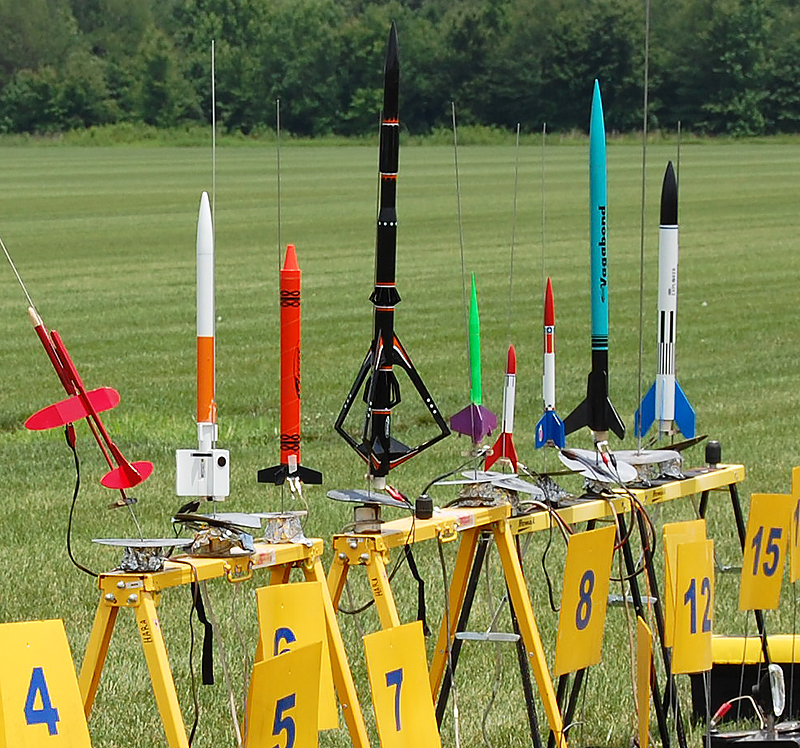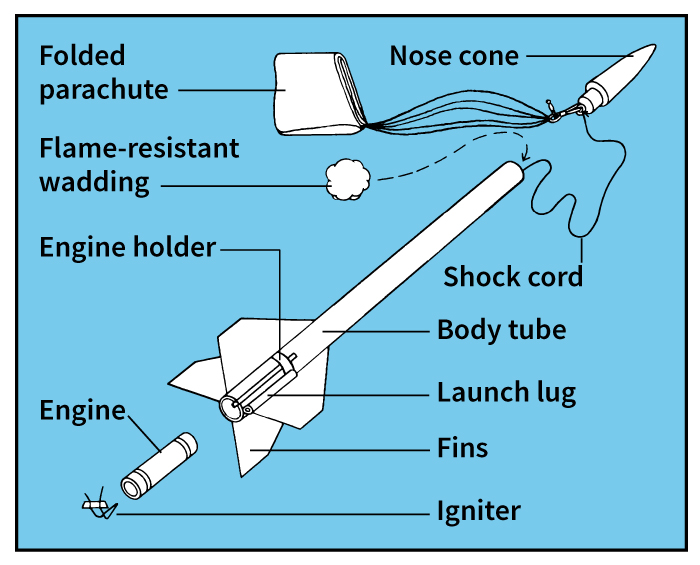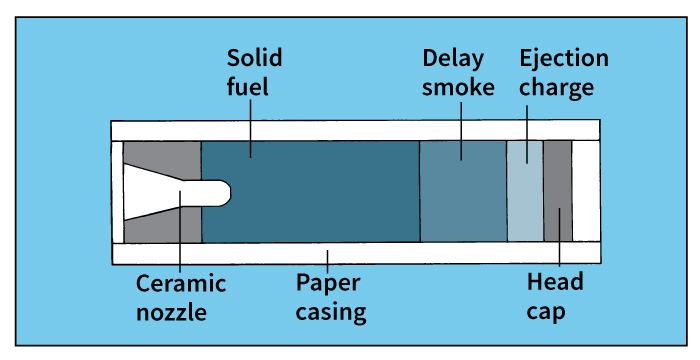Rocket, Model, is a miniature rocket patterned after military or space rockets. Model rockets fly the same way as do military or space rockets. But models weigh less than 31/2 pounds (1.5 kilograms), and they usually measure only 8 to 24 inches (20 to 61 centimeters) long. Model rockets are also known as space models.

The engine of a model rocket produces its power by burning a specially manufactured solid fuel . Model rockets can rise as high as 2,000 feet (610 meters) in a few seconds, traveling as fast as 300 miles (480 kilometers) an hour. Some kinds of model rockets carry a payload. A payload is any small cargo, such as a miniature camera or a radio transmitter. A few model rockets have two or more sections called stages assembled on top of one another. Each stage has an engine that starts to operate when the previous stage’s engine burns out.
Large numbers of young people and adults build and fly model rockets as a hobby . Most rocketeers build their first rockets with kits sold by hobby stores. Model rocketry is educational, because it teaches principles of science and mathematics.
Model rocketry is a safe hobby, but certain rules must be followed at all times. (1) Rockets must be powered by factory-made engines . (2) Rockets must be built of such lightweight materials as cardboard, plastics, and balsa wood, with no metal structural parts. (3) Rockets must be launched with electrical equipment from a distance of at least 15 feet (4.6 meters) and not in winds over 20 miles (32 kilometers) per hour. (4) The launching device must be pointed within 30 degrees of vertical. (5) Rockets must have a recovery system to provide a safe landing. In addition, payloads should never include a live animal or a flammable or explosive substance.
Parts of a model rocket
Every model rocket has seven basic parts: (1) the body tube, (2) the launch lug, (3) fins, (4) the engine holder, (5) the engine, (6) the nose cone, and (7) the recovery device. In addition, a rocket also has a launch system to get it into the air.

The body tube
is the main airframe. It is made of cardboard.
The launch lug
is a narrow paper or plastic tube fastened to the side of the body tube. It fits loosely over the launch rod, a long, vertical metal rod that is part of the launch system. During liftoff, the launch lug guides the rocket and keeps it vertical.
Fins
help the rocket travel straight during flight. Most model rockets have three or four winglike fins on the bottom of the body tube. The fins are made of cardboard, plastics, or wood.
The engine holder,
or engine mount, securely retains the engine in the body during the flight.
The engine
of most rockets consists of a thick cardboard tube that contains the solid fuel. Such an engine can be used only once. The amount of energy contained in the engine is indicated by a letter in an alphabetical label code. The power levels of model rocket engines range from “A” to “G,” with the energy level increasing by twice the power of the previous letter. For example, a “C” engine has twice the power of a “B” engine and can send a rocket twice as high.
The nose cone
is a rounded wood or plastic point that reduces air resistance.

The recovery device
returns the rocket slowly to the ground. One such device is a small parachute or streamer made of paper, cloth, or plastic film. It is carried inside the body tube behind the nose cone. At the height of the flight, an ejection charge in the engine forces the nose cone forward and separates it from the body tube. This forward movement also releases the parachute.
The parachute is attached to the nose cone and the body tube by a strong shock cord made of rubber or other elastic. This cord prevents the parachute from tearing away from the rocket after the ejection. A wad of flame-resistant material is inserted into the body tube between the parachute and the engine. It protects the parachute from the heat of the ejection charge.
The launch system
consists of a launch pad and an engine ignition system with a battery . A typical launch pad is made up of a three-legged base, the launch rod, and a deflector. The deflector keeps the engine’s hot exhaust gases from coming into contact with the launch pad or the ground.
The ignition system includes a switching device called the launch controller and a battery. Wires connect the launch controller to the igniter, a special wire inserted into the engine. When the operator presses the launch button of the controller, an electric current from the battery makes the igniter become hot. Heat produced by the igniter starts the engine.
Building and flying model rockets
The kits used by many model rocketeers include all parts except the engine and the launch system, which must be purchased separately. Other necessary materials include an adhesive, sandpaper for smoothing the rocket’s surfaces, and a sharp knife for cutting out the fins or other parts. Many enthusiasts paint their completed models to make them look more realistic.
Before flying a model, a rocketeer should find out if model rocketry is regulated by any laws in his or her area. Next, the rocketeer selects a safe launch site. The site should be a large, open area away from power lines, tall buildings, and trees. It also should be free of anything that could burn easily, such as dead grass or dry weeds. The length of the shortest side of the site should measure at least a fourth of the highest altitude that the rocket will reach.
At the launch site, the rocketeer installs the engine and mounts the rocket on the launch pad. After making sure that all spectators are a safe distance from the rocket, the rocketeer calls out a 5-second countdown and presses the launch button. The rocket lifts off and soars into the air. At its maximum altitude, the rocket releases its recovery device and floats to the ground.
Model rocket clubs and competition
Local model rocket clubs may be formed among almost any organization, such as a school or youth group. The groups also may have their own launch systems and other equipment. Many clubs hold contests. One contest is egg-lofting, which involves launching a rocket that carries an egg. Each contestant sends a rocket as high as possible and tries to recover the egg unbroken. The Team America Rocketry Challenge (TARC) is the world’s largest model rocket egg-lofting contest. Hundreds of student teams compete annually in the TARC.
Several countries have national model rocket organizations. They set up safety rules, certify model rocket engines, issue publications, and charter local clubs. The national organization in the United States is the National Association of Rocketry (NAR) in Marion, Iowa. Model rocket clubs can become chartered sections of the NAR. The Canadian Association of Rocketry (Association Canadienne de Fuséologie) is in Lethbridge, Alberta. Through associations, rocketeers can set flight records and become national or world champions. The world championships are held every two years.
